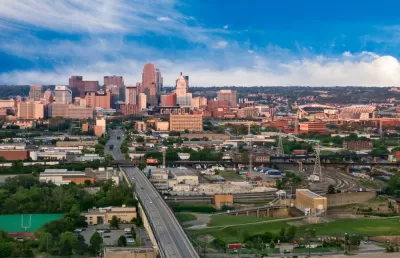Identifying potential hubs and activity centers allows regions to foster economic growth and density.

"To be economically competitive, state, regional, and local leaders need to align their infrastructure, economic development, and land-use policies to support and grow concentrations of activity, rather than encourage sprawl," write Tracy Hadden Loh and Joanne Kim.
Economic mapping is a strategy that looks at areas based on a range of key measures to bring together regional planning and strategized economic development. In Cincinnati, for example, Plan Cincinnati is a guide for future planning:
Twelve working groups examined the city’s assets and opportunities around key elements ranging from arts and culture to fiscal impact, governance, and infrastructure. Based on the findings, the city mapped existing and potential activity centers and now prioritizes its resources to support their growth.
Loh and Kim discuss other economic mapping efforts in Portland, Oregon, Northeast Ohio, and Washington, D.C. "Far more cities and metro areas need to better coordinate their strategies for increasing the quality of existing concentrations of activity, and expand investments into places with potential to become such hubs," they say.
FULL STORY: ‘Economic mapping’ can help cities target the best places for density and growth

Study: Maui’s Plan to Convert Vacation Rentals to Long-Term Housing Could Cause Nearly $1 Billion Economic Loss
The plan would reduce visitor accommodation by 25,% resulting in 1,900 jobs lost.

North Texas Transit Leaders Tout Benefits of TOD for Growing Region
At a summit focused on transit-oriented development, policymakers discussed how North Texas’ expanded light rail system can serve as a tool for economic growth.

Why Should We Subsidize Public Transportation?
Many public transit agencies face financial stress due to rising costs, declining fare revenue, and declining subsidies. Transit advocates must provide a strong business case for increasing public transit funding.

How to Make US Trains Faster
Changes to boarding platforms and a switch to electric trains could improve U.S. passenger rail service without the added cost of high-speed rail.

Columbia’s Revitalized ‘Loop’ Is a Hub for Local Entrepreneurs
A focus on small businesses is helping a commercial corridor in Columbia, Missouri thrive.

Invasive Insect Threatens Minnesota’s Ash Forests
The Emerald Ash Borer is a rapidly spreading invasive pest threatening Minnesota’s ash trees, and homeowners are encouraged to plant diverse replacement species, avoid moving ash firewood, and monitor for signs of infestation.
Urban Design for Planners 1: Software Tools
This six-course series explores essential urban design concepts using open source software and equips planners with the tools they need to participate fully in the urban design process.
Planning for Universal Design
Learn the tools for implementing Universal Design in planning regulations.
City of Santa Clarita
Ascent Environmental
Institute for Housing and Urban Development Studies (IHS)
City of Grandview
Harvard GSD Executive Education
Toledo-Lucas County Plan Commissions
Salt Lake City
NYU Wagner Graduate School of Public Service



























